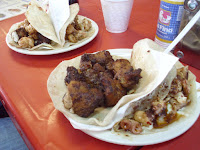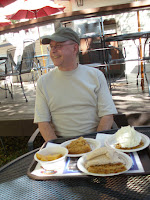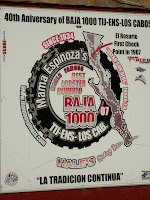The Baja border-to-tip road trip is such a tradition that it's been turned into a sporting event, the
Baja 1000 (by Americans, of course). Having only six days for our trip, a race would've been the only way we could've made it all the way from Tijuana to Los Cabos. Instead, we decided to take our time and make it only part way, to Bahía de los Ángeles, which is about a third of the way down the peninsula on the Sea of Cortez side.
After getting a not-so-early start, we sped as fast we could through Rosarito and Ensenada, hoping we could reach Bahía de los Ángeles in a day. But by the time we reached
El Rosario, we realized that we might need to adjust our schedule. Since it was already about dinner time and we had only made it slightly more than halfway, we had to decide whether to head into the desert. After we found some promising camping entries in the guidebook, we pushed on, after picking up some lobster burritos from
Mama Espinoza's, a popular -- and overpriced -- pit stop for many race fans.
The sun was setting by the time we drove into
Cataviña. It was so late that when we started setting up our tent at
Rancho Santa Inés, a few miles outside of town, no one even came to ask for the camping fee. It wasn't until the morning that the owner drove up to collect the $7 or so. His Pinto kicked up some dust, but the air was filled more by clouds of butterflies (top), which either had hatched overnight or were simply more active in the morning. Before we got going for the day, we headed back into town to fuel up. Our car tank was still pretty full, so we didn't need to stop at the makeshift gas station (bottom left). But our human tanks were pretty empty after the not-very-filling lobster burritos; we were soon bloated on tacos of birria and the biggest chile rellenos ever (bottom right).
Cataviña and the campground were in the middle of the
Valle de los Cirios (left), a federally protected ecological area that covers 35 percent of Baja California Norte state. The government is trying to encourage ecotourism in the area in order to protect unique species of insects, birds, and plants that thrive in the area. The valley is named after the
Cirio columnaris, also known as Boojum (from
Lewis Carroll's poem "The Hunting of the Snark") trees, a more fitting name for the fantastical Seuss-like stalks (right).
After a lot of cirios, rocks, and sand, we finally arrived in
Bahía de los Ángeles. We checked out a few camping areas before we settled on Campo Archelón, mainly because of its ambiance and attitude. The palapa-covered stone huts were once used by sea-turtle researchers (top left); technically, we didn't even need a tent, as the camp provides cots if you just want to sleep in the open air. Of course, the location wasn't so bad either; it was less than 20 feet from our tent to the water (top right). In the morning, we could crawl out of our sleeping bags and into a borrowed kayak for a quick paddle (bottom left), and in the evening, we could watch the sun set from the fire pit right outside our hut (bottom right).




With few other humans around, it was nice to be able to focus on the animals. Apparently, whales come through the "Canal de Ballenas," a deep channel close to in-sight Isla Ángel de la Guardia, but we were content to watch the feeding frenzy of fish and fowl every morning (left). We were not so happy to see a scorpion about to feed on TJ's leg. Usually, we're not one to kill animals, but not knowing if it was dangerous, we couldn't risk a bite to ourselves or Sage, so it became a part of our dirt floor (right). As it turns out, I think the creature was a
bark scorpion, which is considered life-threatening, so I feel even less guilty about it getting smooshed.
It was tempting to just lounge by the beach, and we did, but we also ventured to the north and south of the bay. To the north, we headed into the
La Gringa property (left), an ultra-primitive camping area (trash cans only). We snorkeled off the beach there (right) and saw the same kinds of colorful reef fish as back on our beach but in bigger numbers. Plus, I'm pretty sure I saw an octopus hiding out under a rock, but after our scorpion encounter, I wasn't about to tempt fate and antagonize it.
To the south, after bouncing along rocky, rutted roads, we helped dig out an American couple whose car had become stuck in mud left from earlier rains. We chose to turn around ourselves, and they directed us to a garden of saguaros, which were just as tall but even more dense than
the area in San Felipe near the Valle de los Gigantes.
After two nights in near-solitary paradise, we started our return trip. We stopped for one last look at the bay and
Isla Ángel de la Guardia before we headed into desolate but beautiful Parque Natural de Desierto Central de Baja California, with the intention of leaving the hot coast for the cool mountains of Sierra San Pedro Mártir.
Once again, we didn't make quick time like we had hoped, so we had to stop for a night in
San Quintín, which leaves little to be desired, according to our guidebooks. Much to our delight, we ended up at
El Pabellón campground, whose RV sites were just over high dunes from the sandiest, whitest beach I've seen in Baja.
Apparently, the park had once been quite popular -- especially for caravaners following the whale trail, as indicated by the ballena skeleton at the entrance (left) -- but only us and another brave soul were braving the chilly winds on a cloudy, misty night. The next morning, before climbing into the hills, we stopped to check out the
Old Mill, an institution for sport fishermen; however, the boats harbored in the inlet were empty, and only one man was fishing, with a unpoled line (right).
We got up the to the highest mountain range in Baja California just after the
Observatorio Astronómico Nacional had closed to visitors for the day. The observatory moved three times before settling in the state, which has proven to be the best in terms of high astronomical alignment and low light pollution; it now has three telescopes on the
Universidad Nacional Autónoma de México (UNAM) grounds.
The
Parque Nacional San Pedro Mártir was as close to a U.S. state or national park as I've found in Mexico. There was a ranger station and interpretive center, with even a ropes course; the trails were well-marked, and the campsites were well-maintained. It was a shame that more people weren't taking advantage of its offerings, including us -- we had time for only a short walk in the morning before we had to head back home.
The trip was one of extremes, from low to high ground, from hot to cold climes. And TJ went to extremes in terms of his campfire cooking, too. Sadly, even though Bahía de los Ángeles is known for its deep-sea fishing, the only seafood we could dig up was some frozen shrimp. However, they were perfectly meaty for skewers (left), and we even had enough left over to turn them into shrimp tostadas the second night (right). In San Quintín, we didn't land any of its famous smoked clams, but TJ found some raw ones, which cooked up into a hearty soup (bottom).
Of course, a good road trip requires some good street eats. Besides the lobster burritos, we packed up some tortas, and some advice, from a highway-side shack near the turnoff to San Pedro Mártir (left). And in the middle of the desert between Cataviña and El Rosario, we sustained ourselves with some authentic
machaca burritos (right).
All in all, we were well-fed by the trip, both in terms of actual sustenance and the spiritual kind. It was nice to be reminded that there's more than one temperature to Mexico, even within a third of a of peninsula that makes up less than a third of the country.











































































